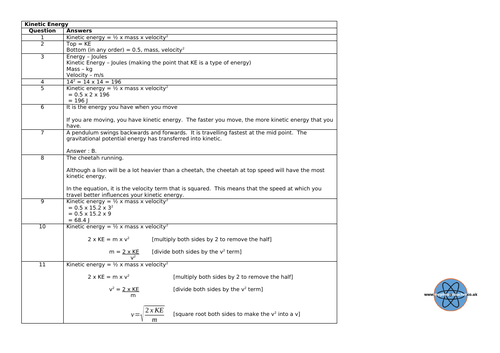






There are 14 differentiated questions around using the physics concepts of resultant kinetic energy calculations.
Students feedback says that they love the layout. They can measure their own progress and it is easy and quick to mark and leave specific feedback (the answers include a full method). It has been designed to build confidence as well as low-stakes competition into lessons. Like students do in maths, students will be able to apply equations and use the triangle method for rearranging.
The font used is “OpenDyslexic” - this helps students with dyslexic tendencies to access the work easier. More information can be found on their open dyslexic website. This is saved as a pdf to keep the font working (if you have not got it installed. The word version is also included so that you can choose your own font and edit the document.
Typical layout of questions (most worksheets have around 14 questions) where Q1 is simplest and Q14 is hardest.
Example:
- Q1 to 5 - 1 Chilli (Low demand). Focussed around remembering equations (students should use mini whiteboards or scrap paper for repetition)
- Q6 to 8 - 2 Chilli’s (Low/Middle Demand). Focused around using the equation - e.g. simple conversion or having to rearrange the equation.
- Q9 to 11 - 3 Chilli’s (Middle/High Demand). Rearranging the equation and using conversions.
- Q12 to 14 - 4 Chilli’s (High Demand). Stretch questions, e.g. towards Year 12 or short written answers.
Designed so that students can choose where to start, although the highest ability will want to complete all of the questions.
Questions answered from the 1st column give you 1 chilli each. Column 2, each question is worth 2 chillis etc. At the end, count the chilli’s that the student has and this suggests a current working at grade.
Perfect for:
• Assessing prior knowledge
• Homework (easy to mark and suggest how to move forward as focused around skills of using equations).
• Starters / plenaries - part of “low stake” tests - build up a series of “mini-marks” on a tracker sheet before larger tests so students can identify their strengths and weaknesses.
• Recall and Retrieval
• Metacognition
• Self-monitoring
• Revision
• Cover lessons (fully explained mark scheme that can support students and non-specialist teachers)
Get this resource as part of a bundle and save up to 23%
A bundle is a package of resources grouped together to teach a particular topic, or a series of lessons, in one place.
GCSE Physics / Combined Science Differentiated Equation Worksheets suitable for homework, revision and assessment
A bundle of 20 worksheets that I have created so far. Each have fully explained answers.
Kinetic Energy Bundle - GCSE Physics / Combined Science Differentiated Equation Worksheets
A collection of resources and a YouTube video to help with Kinetic Energy. All questions have fully explained answers
Kinetic Energy GCSE Bundle - scaffolded worksheet and multiple choice exam style questions with fully explained answers
Contains two resources and a link to a YouTube (also available on my YouTube channel). Resource 1 - Chilli worksheet - differentiated / scaffolded levels of challenge Resource 2 - Multiple choice - a challenge for students, easy for teachers to mark, allowing more time for meaningful feedback. Written in a style similar to that of an exam paper. Resource 3 (free) - Equation Poster
Something went wrong, please try again later.
This resource hasn't been reviewed yet
To ensure quality for our reviews, only customers who have purchased this resource can review it
Report this resourceto let us know if it violates our terms and conditions.
Our customer service team will review your report and will be in touch.